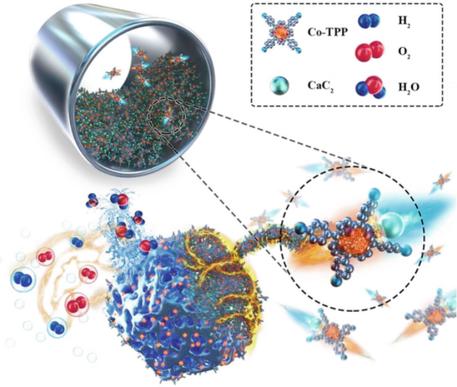Single-atom catalysts (SACs) can be used as single-atom nanoenzymes, which is a new-generation nanoenzyme with rapid development in recent years. It has been widely applied in biosensing, disease diagnosis and treatment, biological imaging and other fields. Single-atom nanoenzymes have diffuse single-atom structures and favorable coordination environment, and also possess significant catalytic activity and stability. The high utilization rate of atoms and the uniform structure of single-atom sites offer SACs with high activity and selectivity, which provides an ideal platform for the study of catalytic mechanism at the atomic level. Until now, pyrolysis from selected precursors containing carbon, nitrogen and metal species has been the most common strategy to obtain SACs. At present, it is still a critical challenge to establish a versatile strategy for preparing well-defined SACs.
Doctoral student Liu Xiaofei, member of Professor Lyu Yi’s team from Surgical Dreamworks of Xi 'an Jiaotong University (XJTU), published an article entitled "Pyrolysis-free, Facile Mechanochemical Strategy Toward Cobalt Single-Atom/Nitrogen-doped Carbon for Highly Efficient Water Splitting" inChemical Engineering Journal. Liu Xiaofei, the corresponding author of this article, was one of the first-batch outstanding Class A young talents of XJTU. The First Affiliated Hospital of XJTU was the first corresponding affiliation.
In this study, a facile one-step mechanochemical-induced self-sustaining reaction was proposed to fabricate cobalt SACs supported by nitrogen-doped carbon (Co-BM-C) via direct milling of cobalt (II)5,10,15,20-tetrakis-(4'-bromophenyl) porphyrin (Co-TPP-Br) and calcium carbide.

Schematic diagram of Co-BM-C synthesis
The key to success is that firstly, the bromine group in Co-TPP-Br can react with calcium carbide under ball-milling conditions. Mechanochemical-induced method can directly form carbon matrix to stabilize metal sites. Secondly, proper selection of cobalt porphyrin skeleton provides a suitable interaction to stabilize the cobalt sites in the self-sustaining reaction. Consequently, the cobalt SACs supported by nitrogen-doped carbon were successfully obtained through rapid grinding (15 min) without the utilization of pre-prepared carbon support or further pyrolysis procedure. In addition, the obtained Co-BM-C exhibited excellent for oxygen evolution and hydrogen evolution in 1 M KOH. The present study not only contributes to understanding the catalytic nature of nanoenzymes at the atomic level, but also provides theoretical support for the design and activity regulation of nanoenzymes. It offers significant guiding value for green and simple research and development of novel biomedical materials and new drugs.
This study was financially supported by National Key Research and Development Program and National Natural Science Foundation of China.
Article link:https://www.sciencedirect.com/science/article/pii/S1385894721056631